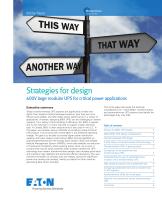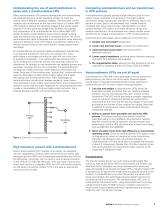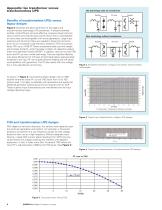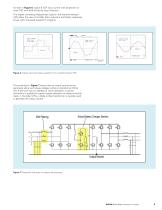 Website:
Powerware
Website:
Powerware
Group: EATON Electrical
Catalog excerpts

Strategies for design600V large modular UPS for critical power applications Executive summary Today's transformerless UPS systems are significantly smaller and lighter than isolation transformer-based systems, plus they are more efficient and reliable, and offer better power performance in a variety of applications. However, designing 600V UPSs can be challenging in several respects, from safety to fault handling to efficiency. Yet, 600V is popular due to the reduction in current required to support a given electrical load. In Canada, 600V is often required and is also used in the U.S.. In this paper, we consider various methods of providing a state-of-the-art UPS product in an environment where 600V is the preferred operating voltage. The goal is to be able to provide higher power distribution capacity and lower copper costs (versus 480V) and still capitalize on sophisticated features like the Energy Saver System (ESS) and Variable Module Management System (VMMS), which add reliability via reduction of mechanical complexity while lowering power costs. As a result, a compromise may be struck between older isolation transformer UPS technology and modern transformer-free designs that provides good value and maintains high reliability and extremely efficient operations. The user receives the benefit of compact size and weight, along with significant power and cooling cost savings, freeing up capital for other revenuegenerating data center activities. This white paper discusses the technical considerations for "native 600V," transformerless, and autotransformer UPS systems and details the advantages they may offer. Table of contents Choices for 600V UPS designs 2 Native 600V UPS design considerations 2 A brief history of transformerless UPS technology 2 Transformerless UPSs: A growing trend 2 Comparison of iso transformer and transformerless UPSs 2 Understanding the use of autotransformers in series with a transformerless UPS 3 High resistance ground with autotransformers 3 Comparing autotransformers and iso transformers in UPS systems 3 Autotransformer UPSs are not all equal 3 Appendix: Iso transformer versus transformerless UPS 4
Open the catalog to page 1
Choices for 600V UPS design Traditionally, the input and output voltage of a UPS were set via a transformer. The UPS input transformer may step the utility voltage up or down to provide the optimum voltage to the UPS rectifier electronics. The UPS output transformer acts to step up or down the raw inverter output voltage to match the user's requirement, typically 208V, 400V, 480V, or 600V In fact, either an isolation (or "iso") transformer or an autotransformer may be used to perform these voltage transformations. However, a transformerless UPS has neither an input nor an output...
Open the catalog to page 2
Understanding the use of autotransformers in series with a transformerless UPS Comparing autotransformers and iso transformers in UPS systems Many transformerless UPS systems domestically and internationally are designed around a certain operating voltage. To meet the market need of different operating voltages, manufacturers of UPS modules use transformers on the input and output of a native 480V UPS module to achieve the operating voltage of the overall system required. The new operating voltage could be 600V, for example. The incorporation of an autotransformer into a native 480V UPS...
Open the catalog to page 3
Appendix: Iso transformer versus transformerless UPS Old technology with iso transformer Benefits of transformerless UPSs versus legacy designs Figure 2 illustrates the basic schematic of the legacy and transformerless technology UPS powertrain. A phase-controlled rectifier, while efficient and cost-effective, produces large harmonic input currents and reduced input power factor that is unacceptable at many sites and incompatible with some generators. Large input inductors and harmonic filters are needed to bring the harmonics down to 5 to 10 percent total harmonic distortion (THD) and...
Open the catalog to page 4
As seen in Figure 6, typical 6 SCR input current with 30 percent or more THD with di/dt limited by input inductors. The higher switching frequencies used in the transformerless UPS allow the use of smaller filter inductors and faster response times with improved waveform integrity. Figure 6. Typical input and output waveforms of a transformerless UPS. The powertrain in Figure 7 shows that an output neutral can be generated along with phase voltages without a transformer. While only three-wire input is needed for online operation, a neutral connection is needed to support bypass operation or...
Open the catalog to page 5
About Eaton Eaton is a power management company with 2014 sales of $22.6 billion. Eaton provides energy-efficient solutions that help our customers effectively manage electrical, hydraulic and mechanical power more efficiently, safely and sustainably. Eaton has approximately 99,000 employees and sells products to customers in more than 175 countries. For more information, visit www.eaton.com. For more information, visit Eaton.com/9395 Eaton 1000 Eaton Boulevard Cleveland, OH 44122 United States Eaton.com © 2015 Eaton All Rights Reserved Printed in USA Publication No. WP153017EN / GG...
Open the catalog to page 6All Powerware catalogs and technical brochures
-
Eaton 3S UPS
2 Pages
-
5 series UPS
8 Pages
-
TS50
126 Pages
-
Product catalogue
118 Pages
-
Seismic S-Series Enclosures
4 Pages
-
Surge protection solutions
8 Pages
-
Blanking Panels
2 Pages
-
Eaton RACKPACKIT
4 Pages
-
Surge protection
8 Pages
-
UPS basics
8 Pages
-
Eaton Marine UPS
7 Pages
-
Eaton 9PHD
2 Pages
-
Power Xpert 9395P
20 Pages
-
Eaton 93PM 30-200kW
12 Pages
-
Eaton 93PS UPS
9 Pages
-
Eaton 93PS IT
4 Pages
-
Eaton 93E UPS 80-200kVA
4 Pages
-
Hot Sync Technology
2 Pages
-
Eaton Ellipse PRO
2 Pages
-
Eaton Ellipse ECO
2 Pages
-
Eaton 9155/9355 UPS
8 Pages
-
UPS Quick Guide
3 Pages
-
Internet Protection
1 Pages
-
Eaton Protection Station
2 Pages
-
S-Series Enclosures Brochure
20 Pages
-
Eaton 9315 UPS Brochure
12 Pages
-
Eaton 9170+ UPS Brochure
6 Pages
-
5125 Family Brochure
6 Pages
-
Vantage S2 Brochure
16 Pages
-
Eaton 5S
2 Pages
-
Eaton BladeUPS MBM Brochure
2 Pages
-
Eaton 3S UPS
2 Pages
-
Eaton 9130 Rack UPS
4 Pages
-
Eaton 5PX UPS
2 Pages
-
Eaton 5P Tower UPS
2 Pages
-
Eaton 5SC UPS
2 Pages
-
Data Center Line Card
1 Pages
-
Eaton ePDU Product Catalog
48 Pages
Archived catalogs
-
Powerware Product Catalog
40 Pages




















































